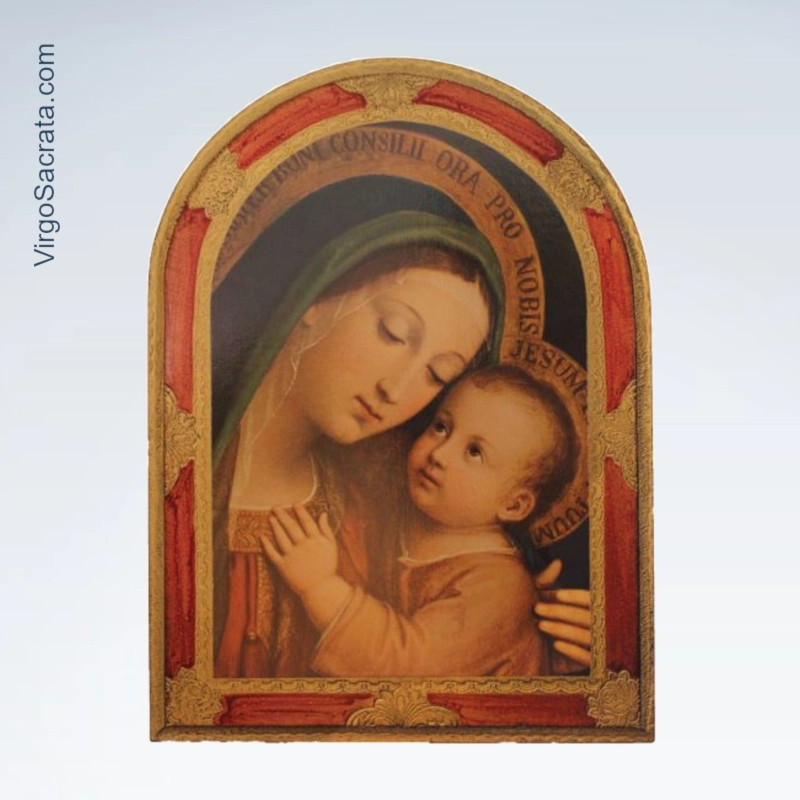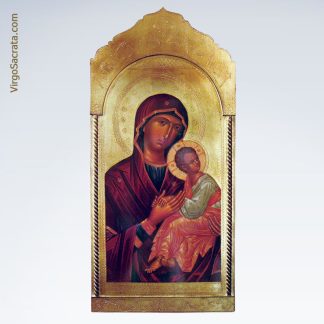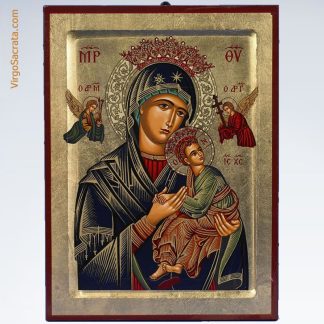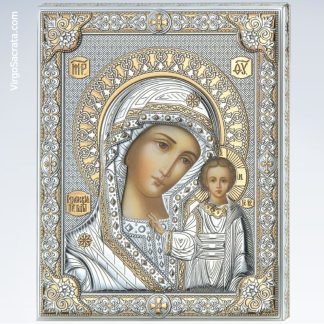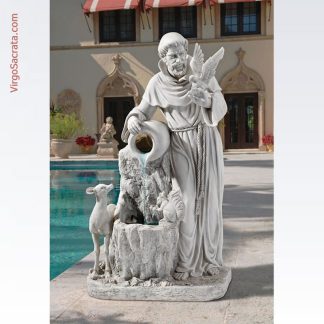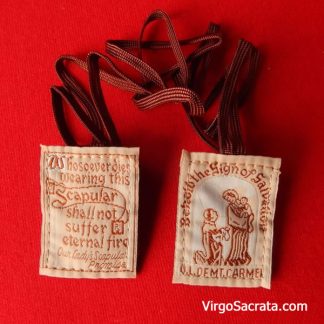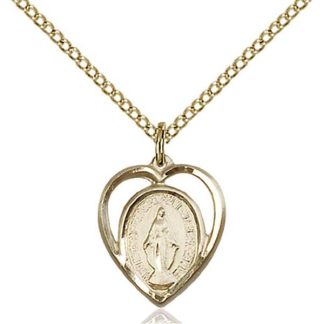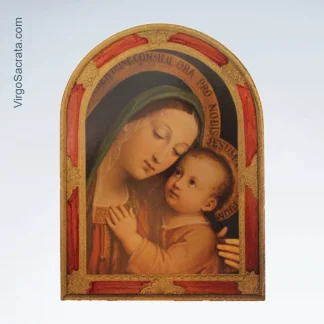Our Lady of Good Counsel Plaque by Sarullo Florentine Plaque. Hand-crafted in Italy.
The miraculous power of Our Lady of Good Counsel, manifested both in Her sacred Image of Genazzano and in copies of this icon found in many places. Our Lady of Good Counsel devotion aims at obtaining all that the gift of Good Counsel gives through the intercession of Mary, the Immaculate Virgin Mother of God, to Whom the Infallible Spouse of Christ attributes the very words of the Holy Ghost: “In me is Counsel”.
Records dating from the reign of Paul II (1464-71) relate that the picture of Our Lady, at first called “La Madonna del Paradiso” and now better known as “Madonna del Buon Consiglio”, appeared at Genazzano, a town about twenty-five miles southeast of Rome, on St. Mark’s Day, 25 April, 1467, in the old church of Santa Maria, which had been under the care of Augustinians since 1356. The venerated icon itself, which is drawn on a thin scale of wall-plaster little thicker than a visiting-card, was observed to hang suspended in the air without the slightest apparent support; thus early tradition, which furthermore tells how one might have passed a thread around the image without touching it. At once devotion to Our Lady in Santa Maria sprang up; pilgrim-bands began to resort thither; while miracles in ever-increasing numbers, of which a register was opened two days after the event, were wrought, as they still continue to be, at the shrine. In July following, Pope Paul deputed two bishops to investigate the alleged wonder-working image. Their report, however, is not known to be extant. The cult of Our Lady increased. In 1630 Urban VIII himself went to Genazzano on a pilgrimage, as did Pius IX in 1864. On 17 November, 1682, Innocent XI had the picture crowned with gold by the Vatican Basilica. In 1727 Benedict XIII granted the clergy of Genazzano an Office and Mass of Our Lady for 25 April, anniversary of the apparition, elsewhere the feast being kept a day later so as not to conflict with that of St. Mark the Evangelist. On 2 July, 1753, Benedict XIV approved of the Pious Union of Our Lady of Good Counsel for the faithful at large, and was himself enrolled therein as its pioneer member; Pius IX was a member, and also Leo XIII. On 18 December, 1779, Pius VI, while re-approving the cult of Our Lady, granted all Augustinians an Office with hymns, lessons, prayer and Mass proper of double-major rite; with a plenary indulgence also for the faithful, to which Pius VIII added another for visitors to the shrine. On 18 December, 1884, Leo XIII approved of a new Office and Mass of second-class rite for all Augustinians, while on 17 March, 1903, he elevated the church of Santa Maria — one of the four parish churches at Genazzano — to the rank of minor basilica; and, on 22 April following, authorized the insertion in the Litany of Loreto of the invocation “Mater Boni Consillii” to follow that of “Mater Admirabilis”. The same pontiff, ten years earlier (21 December, 1893) had sanctioned the use of the White Scapular of Our Lady of Good Counsel for the faithful. In the United States there are many churches and institutions in honour of Our Lady of Good Counsel.
The Catholic Encyclopedia, Volume XI
Nihil Obstat, February 1, 1911, Remy Lafort, S.T.D., Censor
Imprimatur. ✞ John Cardinal Farley, Archbishop of New York
About Florentine Wall Art
Florentine wall art has been around for hundreds of years. When it first developed in the 14th and 15th centuries, in and around Florence, Italy, the gilding with gold leaf of a heavy wood frame was used to highlight an original painting that it surrounded. As prints of originals became more widely available and the demand from the public increased, a more affordable process came about; that of decorating a wood board with gold leaf surrounding the print. In order to make the final outcome as beautiful as possible, a labor intensive process soon developed.
First, a board was cut on which to mount the print, as different shapes of boards worked better with different prints. Next the unfinished wood is coated with a white paste which is allowed to dry. Gold leaf or gold paint is applied to the outer edges of the board.
The gold leafing adds 25-30% to the cost as it contains real gold which adds to the brightness and luster of the piece. The print is glued onto the board and then the real craftsmanship that was developed over many years begins. The reason for applying the white paste in an earlier stage is so that the artisans can use the many different tools that they have to put lasting, physical impressions into the borders surrounding the print. The final touch is then applied, coating the entire piece with a very light antique lacquer to give it an “Old World” feel.

